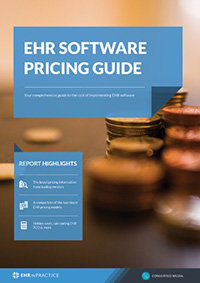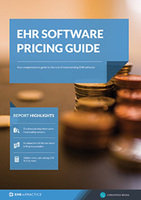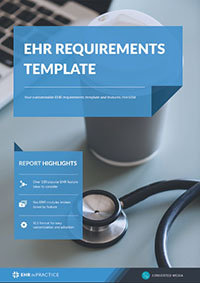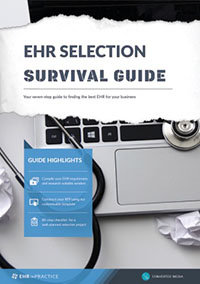The ultimate EHR selection process: 5 steps to the best EHR
An effective EHR selection process provides a healthcare organization with the ability to mitigate several of the problems that arise from a selection process that does not position a selection team to choose an EHR that best aligns with their organization’s strategy. A flawed selection process results in a number of issues that can plague practices. The issues that can arise from a failed or partially flawed selection process include, but are not limited to, reduced productivity, poor user satisfaction, administrative inefficiency, and reduced quality of care. The inefficiencies that arise from selecting an EHR product that, for any number of reasons, is not suitable for a practice can not only create functional problems, with regard to how a practice delivers care and manages its business operations, it can also result in short term and long term financial costs that can place an organization at a significant disadvantage.
Luckily, you’re not the first to select a new EHR (and you won’t be the last). You can harvest hindsight from hundreds of EHR projects by following this process which will outline how to...
- Build a team which represents your practice
- Gather clear and critical practice requirements
- Outline a budget which can deliver requirements
- Shortlist vendors who match selection criteria
- Identify your next EHR using RFPs and demos
A note on EHR selection
An EHR’s suitability for a practice depends on aligning a software’s functionality and features with a practice’s requirements. Selecting an unsuitable EHR product can not only result in reduced efficiency and quality of care, it can also negatively impact satisfaction among clinicians and administrative staff. A survey conducted by the KLAS research agency examining multiple EHR satisfaction surveys found that 70% of the variance in satisfaction between organizations can be accounted for by considering training, trust in IT (or organizational culture), and the level of EHR personalization.
Getting the latter factor right, the level of EHR personalization depends on an effective selection process that can effectively determine a practice’s technology needs and find a product that aligns with these needs. The key link between a practice’s needs and a product that fulfills these needs is reliable and actionable information.
A successful selection process is built on a foundation of reliable and actionable information. Reliable information is information collected from vendors and stakeholders that offers a selection team an accurate and comprehensive view of their own organization’s requirements and how the available vendor products align with those requirements. Actionable information refers to information a selection team can act upon to make an informed selection.
How an organization can obtain both reliable and actionable information depends on understanding where to find reliable and actionable information, collecting this information and analyzing is an important process selection teams often fail to execute. The failure to obtain reliable and actionable information can have serious consequences that can manifest in low levels of EHR satisfaction, reduced productivity, and reduced efficiency.
Obtaining the goal of related to obtaining reliable and actionable information must first, and most importantly leverage an organization’s human resources. Selection teams will discover that a valuable source of information that can aid the selection process can be found among those who provide care and those who handle their organization’s administrative functions. These key stakeholders can provide valuable insight and important information that can guide the selection process such as the features and requirements needed to deliver quality care in an efficient manner.
1. Build a team which represents your practice
To deliver on this process you need a team around you which represents the practice with process expertise, and perhaps more importantly, time. A template selection team should represent practice stakeholder groups and often includes:
- Project Manager - *hint* you're a good candidate if you're taking time to research this
- C-Level Sponsor - the voice of senior management
- Physician Advocate - represent physicians during requirements and shortlisting
- Nurse Advocate - represent nurses during requirements and shortlisting
- Billing Advocate - represent billing department during requirements and shortlisting
- Administrative Advocate - represent practice management team during requirements and shortlisting
- Meaningful-Use Manager- required if MU attestation will influence requirements
- Marketing Manager - useful for input on communications and user adoption
Alongside these team members you should task your advocates with creating representative user groups from the relevant stakeholder discipline.
2. Gather clear and critical practice requirements
With your selection team in place, you can begin to identify the features you want your new EHR to deliver.
Step away from the software shortlist.
Starting to look at systems now is the most common mistake made during requirements gathering. A far more sensible and productive approach is:
- Identify user groups from each stakeholder discipline e.g lab analysts, physicians
- Conduct process audits with each user group
- Map out critical processes (electronic and otherwise)
- Identify bottlenecks within these processes
- Categorise bottlenecks as software, hardware or user-based
- Create requirements for EHR to solve bottlenecks (this is best done in conjunction with the relevant advocate for that department)
- Review requirements list with C-level and MU-manager for approval
Follow this process and you will have a requirements list which is free from “product bias” and a true representation of practice requirements. Fail to follow this process and you will get…
… a list as long as the ICD-10 codes.
3. Outline a budget to deliver on requirements
With your requirements list in place, you can forecast the budget required to meet these requirements.
Look away now finance department.
How much does EHR software cost?
A budget for EHR software depends on a whole host of factors, but industry data places a cost range at between $15,000 to $162,000. More recent EHR research data found this figure was closer to $6,200 per user, on average, over a five year period. The short answer to the actual cost of EHR is, unfortunately, it depends. Let's look at some reasons why.
Factors that affect the cost of EHR:
- Choice of platform ie. SaaS vs perpetual license
- Number of users
- Reliance on external consultancy
- Training requirements (existing and new staff)
- Security audits
The good news is that these costs tend to be proportional to the scale of your practice and upfront costs can be reduced by making wise choices.
Guide: EHR pricing guide - the latest pricing from leading vendors
4. Shortlist vendors who match selection criteria
With a budget and requirements list in place, you have all the ingredients for an EHR shortlist minus the EHR software itself. Right?
Wrong. Step away from the software shortlist.
Though common sense should prevail in most cases, it is still worth defining your selection criteria before you shortlist. Common EHR selection criteria include:
- Affordability - is the system within budget?
- Suitability - can the system cater for your requirements?
- Culture - can you form a strong partnership with the vendor?
- Efficacy - can the system deliver practical results?
With affordability and suitability covered by your budget and requirements respectively, let’s talk a little about culture…
The importance of assessing EHR vendor culture
Some people consider company culture to be defined by table tennis tables in the office, free food and nap rooms.
But researching culture can answer so many questions about the EHR vendors you are shortlisting:
- Are you going to get the hard sell from their sales team?
- Do the vendor’s employees actually like the product?
- Will your vendor’s support team be motivated and happy to help?
“How do you get the answers to those questions?” I hear you say…
The answer? Glassdoor.
Glassdoor is a review site for employers. Employees can have their say on culture, management and more. Gold dust when assessing EHR vendors.

Were not in the business of naming names (that’s your shortlists job), but here are some examples from real company profiles:
- “Too much work and not enough time to do it in. High-pressure environment. Quantity over quality.”
- “Try to be a bit more lenient with your customer’s pricing especially existing customers”
- “Phenomenal product; and a dedication to constant reflection & improvement. No resting on laurels, really clear + exciting path ahead.”
A small sample, but it is pretty clear which company you should be working with. Disclaimer: no EHR vendors were harmed in the publication of these reviews, hopefully.
5. Identify your next EHR using RFPs and demos
This is where we start looking at suitability and efficacy in depth. Can the product meet your requirements on paper and in a practical environment?
To build and assess your shortlist against your requirements you can use:
- Vendor websites (they will only get you so far)
- Comparison engines
- Request for proposals (RFPs)
- Demos
RFP documents
Creating an RFP document for EHR vendors is a great way to receive clear “yes” and “no” answers on your requirements list (often a challenge on the phone with their sales team). In other words, an excellent way to assess suitability.
An RFP document includes detailed documentation on:
- Your practice (employees, specialty, locations)
- Your EHR requirements
- Your financial expectations for the EHR system (you can reveal as much or as little as you are comfortable with)
- Your expectations from shortlisted vendors
For a full rundown of the process for creating RFPs and evaluating vendor responses, we created this handy guide featuring a template framework…
Demos
With EHR suitability covered by comparison engines and RFP documents, that leaves us with efficacy.
And that’s where software demos come in.
Characteristics of great software demos include:
- Practice-lead rather than vendor-lead
- Closely mapped to your requirements list
- Representative team including physicians, nurses, billing staff etc.
- Objective measurement - predefined scoring criteria are a good start
- On-site demonstration (can be more costly)
The process of conducting demos deserves its own book. In lieu of such a tome, we have put together four steps which should lead you to successful demos…
Guide: Mastering EHR demos in 4 easy steps
A final thought...
The process is complex. The decisions are tough. But…
With an average increase of 27% in the active-patients-to-clinician-FTE (full-time equivalent) ratio on the line, ROI is there for the taking.
Free white paper

EHR Pricing Guide
Get your complete guide to EHR software pricing and project costs. Your headstart on EHR pricing research

Featured white papers
Related articles
-

EHR requirements and key features: your complete guide
Our extended guide to EHR requirements - everything you need to know and more on the subject
-

5 key stakeholders in your EHR selection
Learn about the individuals that, when consulted early and often, can make your EHR selection pro...
-

5 important areas of EHR training during implementation
Successful EHR implementation is not possible without crucial EHR training




